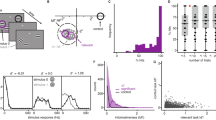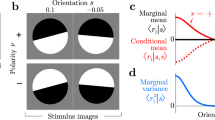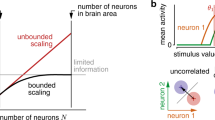Abstract
The ability to adapt to changes in stimulus statistics is a hallmark of sensory systems. Here, we developed a theoretical framework that can account for the dynamics of adaptation from an information processing perspective. We use this framework to optimize and analyze adaptive sensory codes, and we show that codes optimized for stationary environments can suffer from prolonged periods of poor performance when the environment changes. To mitigate the adversarial effects of these environmental changes, sensory systems must navigate tradeoffs between the ability to accurately encode incoming stimuli and the ability to rapidly detect and adapt to changes in the distribution of these stimuli. We derive families of codes that balance these objectives, and we demonstrate their close match to experimentally observed neural dynamics during mean and variance adaptation. Our results provide a unifying perspective on adaptation across a range of sensory systems, environments, and sensory tasks.
This is a preview of subscription content, access via your institution
Access options
Access Nature and 54 other Nature Portfolio journals
Get Nature+, our best-value online-access subscription
$29.99 / 30 days
cancel any time
Subscribe to this journal
Receive 12 print issues and online access
$209.00 per year
only $17.42 per issue
Buy this article
- Purchase on Springer Link
- Instant access to full article PDF
Prices may be subject to local taxes which are calculated during checkout






Similar content being viewed by others
Data availability
Data sharing is not applicable as no datasets were generated or analyzed in the current study.
Code availability
Code was written in MATLAB and is available at https://github.com/HermundstadLab/EfficientAdaptiveCodes.
References
Adrian, E. D. & Zotterman, Y. The impulses produced by sensory nerve endings: part 3. Impulses set up by touch and pressure. J. Physiol. 61, 465–483 (1926).
Kastner, D. B. & Baccus, S. A. Coordinated dynamic encoding in the retina using opposing forms of plasticity. Nat. Neurosci. 14, 1317 (2011).
Ulanovsky, N., Las, L., Farkas, D. & Nelken, I. Multiple time scales of adaptation in auditory cortex neurons. J. Neurosci. 24, 10440–10453 (2004).
Dean, I., Harper, N. S. & McAlpine, D. Neural population coding of sound level adapts to stimulus statistics. Nat. Neurosci. 8, 1684 (2005).
Ollerenshaw, D. R., Zheng, H. J. V., Millard, D. C., Wang, Q. & Stanley, G. B. The adaptive trade-off between detection and discrimination in cortical representations and behavior. Neuron 81, 1152–1164 (2014).
Srinivas, G.-S., Mahmut, D., Junjianjia, L., A, C. D. & Thierry, E. Olfactory receptor neurons use gain control and complementary kinetics to encode intermittent odorant stimuli. eLife 6, e27670 (2017).
Clarke, S. E., Longtin, A. & Maler, L. Contrast coding in the electrosensory system: parallels with visual computation. Nat. Rev. Neurosci.16, 733 (2015).
Fairhall, A. L., Lewen, G. D., Bialek, W. & de Ruyter van Steveninck, R. R. Efficiency and ambiguity in an adaptive neural code. Nature 412, 787 (2001).
Brenner, N., Bialek, W. & de Ruyter Van Steveninck, R. Adaptive rescaling maximizes information transmission. Neuron 26, 695–702 (2000).
Sharpee, T. O. et al. Adaptive filtering enhances information transmission in visual cortex. Nature 439, 936 (2006).
Gutnisky, D. A. & Dragoi, V. Adaptive coding of visual information in neural populations. Nature 452, 220 (2008).
Laughlin, S. A simple coding procedure enhances a neuron’s information capacity. Z. Naturforsch. C Biosci. 36, 910–912 (1981).
Wang, Q., Webber, R. M. & Stanley, G. B. Thalamic synchrony and the adaptive gating of information flow to cortex. Nat. Neurosci. 13, 1534 (2010).
Lesica, N. A. et al. Adaptation to stimulus contrast and correlations during natural visual stimulation. Neuron 55, 479–491 (2007).
Rabinowitz, N. C., Willmore, B. D. B., Schnupp, J. W. H. & King, A. J. Contrast gain control in auditory cortex. Neuron 70, 1178–1191 (2011).
Smirnakis, S. M., Berry, M. J., Warland, D. K., Bialek, W. & Meister, M. Adaptation of retinal processing to image contrast and spatial scale. Nature 386, 69 (1997).
Wark, B., Lundstrom, B. N. & Fairhall, A. Sensory adaptation. Curr. Opin. Neurobiol. 17, 423–429 (2007).
Barlow, H. B. et al. Possible principles underlying the transformation of sensory messages. Sensory Communication 1, 217–234 (1961).
Palmer, S. E., Marre, O., Berry, M. J. & Bialek, W. Predictive information in a sensory population. Proc. Natl Acad. Sci. USA 112, 6908–6913 (2015).
Wang, Z., Stocker, A. A. & Lee, D. D. Efficient neural codes that minimize Lp reconstruction error. Neural Comput. 28, 2656–2686 (2016).
DeWeese, M. & Zador, A. Asymmetric dynamics in optimal variance adaptation. Neural Comput. 10, 1179–1202 (1998).
Weber, A. I., Krishnamurthy, K. & Fairhall, A. L. Coding principles in adaptation. Ann. Rev. Vis. Sci. 5, 427–449 (2019).
Srinivasan, M. V., Laughlin, S. B. & Dubs, A. Predictive coding: a fresh view of inhibition in the retina. Proc. R. Soc. Lond. B Biol. Sci. 216, 427–459 (1982).
van Hateren, J. H. A theory of maximizing sensory information. Biol. Cybern. 68, 23–29 (1992).
Pillow, J. W. Spatio-temporal correlations and visual signalling in a complete neuronal population. Nature 454, 995–999 (2008).
Brinkman, B. A. W., Weber, A. I., Rieke F. & Shea-Brown, E. How do efficient coding strategies depend on origins of noise in neural circuits? PLoS Comput. Biol. 12, e1005150 (2016).
Pitkow, X. & Meister, M. Decorrelation and efficient coding by retinal ganglion cells. Nat. Neurosci. 15, 628 (2012).
Olshausen, B. A. & Field, D. J. Emergence of simple-cell receptive field properties by learning a sparse code for natural images. Nature 381, 607 (1996).
Gjorgjieva, J., Sompolinsky, H. & Meister, M. Benefits of pathway splitting in sensory coding. J. Neurosci. 34, 12127–12144 (2014).
Deneve, S. Bayesian spiking neurons I: inference. Neural Comput. 20, 91–117 (2008).
Nemenman, I. Information theory and adaptation. in Quantitative Biology: From Molecular to Cellular Systems (ed. Wall, M.) 73–92 (CRC Press, 2012).
Wark, B., Fairhall, A. & Rieke, F. Timescales of inference in visual adaptation. Neuron 61, 750–761 (2009).
Kastner, D. B. & Baccus, S. A. Spatial segregation of adaptation and predictive sensitization in retinal ganglion cells. Neuron 79, 541–554 (2013).
Appleby, T. R. & Manookin, M. B. Neural sensitization improves encoding fidelity in the primate retina. Nat. Commun. 10, 1–15 (2019).
Tikidji-Hamburyan, A. et al. Retinal output changes qualitatively with every change in ambient illuminance. Nat. Neurosci. 18, 66–74 (2015).
Lundstrom, B. N., Higgs, M. H., Spain, W. J. & Fairhall, A. L. Fractional differentiation by neocortical pyramidal neurons. Nat. Neurosci.11, 1335 (2008).
Bell, A. J. & Sejnowski, T. J. The ‘independent components’ of natural scenes are edge filters. Vis. Res. 37, 3327–3338 (1997).
Karklin, Y. & Lewicki, M. S. Emergence of complex cell properties by learning to generalize in natural scenes. Nature 457, 83–86 (2009).
Tkačik, G., Prentice, J. S., Balasubramanian, V. & Schneidman, E. Optimal population coding by noisy spiking neurons. Proc. Natl Acad. Sci. USA 107, 14419–14424 (2010).
Fournier, J., Monier, C., Pananceau, M. & Frégnac, Y. Adaptation of the simple or complex nature of V1 receptive fields to visual statistics. Nat. Neurosci. 14, 1053–1060 (2011).
Dragoi, V., Sharma, J. & Sur, M. Adaptation-induced plasticity of orientation tuning in adult visual cortex. Neuron 28, 287–298 (2000).
Yeh, T., Lee, B. B. & Kremers, J. The time course of adaptation in macaque retinal ganglion cells. Vis. Res. 36, 913–931 (1996).
Hosoya, T., Baccus, S. A. & Meister, M. Dynamic predictive coding by the retina. Nature 436, 71 (2005).
Drew, P. J. & Abbott, L. F. Models and properties of power-law adaptation in neural systems. J. Neurophysiol. 96, 826–833 (2006).
Ozuysal, Y. & Baccus, S. A. Linking the computational structure of variance adaptation to biophysical mechanisms. Neuron 73, 1002–1015 (2012).
Cortes, J. M. et al. The effect of neural adaptation on population coding accuracy. J. Comput. Neurosci. 32, 387–402 (2012).
Seriès, P., Stocker, A. A. & Simoncelli, E. P. Is the homunculus ‘aware’ of sensory adaptation? Neural Comput. 21, 3271–3304 (2009).
Doi, E. & Lewicki, M. S. A simple model of optimal population coding for sensory systems. PLoS Comput. Biol. 10, e1003761 (2014).
Latimer, K. W. et al. Multiple timescales account for adaptive responses across sensory cortices. J. Neurosci. 39, 10019–10033 (2019).
Młynarski, W. F. & Hermundstad, A. M. Adaptive coding for dynamic sensory inference. eLife 7, e32055 (2018).
van Hateren, J. H. & Ruderman, D. L. Independent component analysis of natural image sequences yields spatio-temporal filters similar to simple cells in primary visual cortex. Proc. R. Soc. Lond. B Biol. Sci. 265, 2315–2320 (1998).
Tkačik, G. et al. Natural images from the birthplace of the human eye. PLoS ONE 6, e20409 (2011).
Sharpee, T. O. Computational identification of receptive fields. Ann. Rev. Neurosci. 36, 103–120 (2013).
Acknowledgements
We thank D. Kastner and T. Münch for generously providing figures from their work. We also thank V. Jayaraman, M. Noorman, T. Ma, and K. Krishnamurthy for useful discussions and feedback on the manuscript. W.F.M. was funded by the European Union’s Horizon 2020 Research and Innovation Programme under Marie Skłodowska-Curie Grant Agreement No. 754411. A.M.H. was supported by the Howard Hughes Medical Institute.
Author information
Authors and Affiliations
Contributions
W.F.M. and A.M.H. conceived the study, developed the theoretical framework, conducted the mathematical analysis, performed the simulations, interpreted the results, and wrote the paper.
Corresponding authors
Ethics declarations
Competing interests
The authors declare no competing financial interests.
Additional information
Peer review information Nature Neuroscience thanks the anonymous reviewers for their contribution to the peer review of this work.
Publisher’s note Springer Nature remains neutral with regard to jurisdictional claims in published maps and institutional affiliations.
Extended data
Extended Data Fig. 1 Smoothing does not alter results.
a-c, Same results as shown in Fig. 3d-f, here without smoothing. Optimal values of αNL (stars) were chosen prior to smoothing.
Extended Data Fig. 2 Optimal dynamics are robust to parameter variations.
a, b, Optimal nonlinearies (left; shown in Fig. 4d,e) closely resemble those derived by linearly-interpolating parameters between the naively-adaptive code and the fully-biased code (right). Shown here as a function of the system’s posterior belief P(high) = \({P}_{t}^{H}\), for variance adaptation (a) and mean adaptation (b). c, d, The dependence of the offset (upper row) and slope (lower row) of the optimal nonlinearities on the bias αI can be approximated by a line that interpolates between the naively-adaptive code (αI = 0) and the fully-based code (αI = 1). Shown here for variance adaptation (c) and mean adaptation (d), for several different values of the posterior belief P(high).
Extended Data Fig. 3 Abrupt changes in encoding parameters arise from bifurcations in error landscapes.
a,b, Encoding nonlinearies (left panels; shown in Fig. 4d,e) show abrupt changes for small variations in the system’s posterior belief P(high) = \({P}_{t}^{H}\). These changes arise from variations in the underlying error landscapes (right panels) in which a single minimum bifurcates into two minima or vice-versa (a, upper row; global minima marked by red x’s), or when one of multiple local minima becomes the global minimum (a, lower row; b, both rows). In the case of variance adaptation, the error landscape is symmetric to positive versus negative variations in the offset of the encoding nonlinearity (x0), and thus bifurcations in the error landscape lead to two symmetric solutions (a, upper row). In such scenarios, we chose the solution corresponding to the lower value of x0 (marked by circles), because it produces lower spike counts on average.
Extended Data Fig. 4 Balance of errors is robust to changes in volatility.
a, As volatility increases, the posterior is faster to update and the error faster to decay (shown for the naively-adaptive code in response to an increase in variance). b-d, Biased codes produce qualitatively consistent patterns of performance regardless of volatility (upper panels), but the relative impact of biasing the code increases as volatility increases (lower panels). Higher volatility leads to relatively longer periods of mismatch (b, upper), higher mismatched errors and lower matched errors (c, upper), and higher global errors (d, upper). The percent change in each of these errors (measured relative to the naively-adaptive code and scaled by the difference in error between the static and oracle codes) increases as volatility increases (lower row), and the global error is thus minimized for larger values of bias (c-d; circled markers in upper panels).
Extended Data Fig. 5 Entropy coding transforms response levels and reduces average firing rates.
a-c, Entropy coding reassigns response levels to spike counts based on the predicted probability that a response level will be used. a, The encoding nonlinearity partitions stimuli drawn from the actual stimulus distribution (black) or predicted stimulus distribution (red) into discrete response levels. This partitioning determines the predicted (b, left) and actual (c, left) probability with which response levels will be used. b, Entropy coding reassigns spike counts in order of decreasing predicted probability (left); response levels that have higher predicted probability (darker red) will be assigned fewer spikes (middle). This leads to a recoded histogram that is weighted toward lower spike counts (right). The reassignment could be approximated by a quadratic nonlinearity, or by a thresholding exponential nonlinearity. c, The recoding scheme, which is based on predicted probability (b), determines how stimuli sampled from the actual stimulus distribution will be transformed into spike counts. d, Before recoding (left), firings rates do not change in response to a change between low (L) and high (H) stimulus variance, regardless of the value of αI. After recoding (right), all codes show a transient response to both increases and decreases in variance, and time-averaged firing rates are lower (inset). e, Before recoding (left), firing rates increase following a change from low (L) to high (H) stimulus mean, and decrease following a change from high to low mean. After recoding (right), all codes show a symmetric response to increases and decreases in mean, and time-averaged firing rates are lower (inset).
Extended Data Fig. 6 Volatility shapes posterior dynamics.
a,c, As volatility increases (that is, as the switching period decreases), the posterior is faster to respond to both increases (upper) and decreases (lower) in stimulus variance (a) and mean (c). We estimated this timescale by linearly interpolating the posterior before computing the time at which it crosses 0.5. b, When stimulus variance is changing in time, the naively-adaptive code (αI = 0, upper left) is faster to respond to decreases in variance (solid lines) than to increases (dashed lines). In contrast, biased codes (upper middle, right) are faster to respond to increases in variance. This is largely driven by a more rapid response to increases in variance with increasing bias (lower left), but is also weakly affected by a slower response to decreases in variance (lower right). d, The posterior is equally fast to respond to increases and decreases in the stimulus mean (upper row), with a timescale that decreases as bias increases (lower row).
Supplementary information
Supplementary Information
Supplemental Note with mathematical analysis and Supplementary Fig. 1
Rights and permissions
About this article
Cite this article
Młynarski, W.F., Hermundstad, A.M. Efficient and adaptive sensory codes. Nat Neurosci 24, 998–1009 (2021). https://doi.org/10.1038/s41593-021-00846-0
Received:
Accepted:
Published:
Issue Date:
DOI: https://doi.org/10.1038/s41593-021-00846-0
This article is cited by
-
A unifying theory explains seemingly contradictory biases in perceptual estimation
Nature Neuroscience (2024)
-
State and rate-of-change encoding in parallel mesoaccumbal dopamine pathways
Nature Neuroscience (2024)
-
Panoramic visual statistics shape retina-wide organization of receptive fields
Nature Neuroscience (2023)
-
Dynamics of cortical contrast adaptation predict perception of signals in noise
Nature Communications (2023)
-
The structures and functions of correlations in neural population codes
Nature Reviews Neuroscience (2022)



